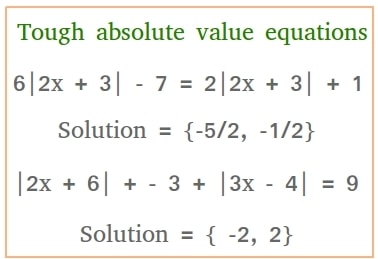How to solve tough absolute value equations
Learn how to solve tough absolute value equations with two carefully chosen examples.

Example #1: 6|2x + 3| - 7 = 2|2x + 3| + 1
Try to have the numbers on the right side. Add 7 to both sides of the equation.
6|2x + 3| - 7 + 7 = 2|2x + 3| + 1 + 7
6|2x + 3| = 2|2x + 3| + 8
Now, try to have the expressions 6|2x + 3| and 2|2x + 3| on the left side. Subtract 2|2x+3| from both sides of the equations.
6|2x + 3| - 2|2x + 3| = 2|2x + 3| - 2|2x + 3| + 8
6|2x + 3| - 2|2x + 3| = 8
Finally, you need to make an important observation.
Notice that 6|2x + 3| and -2|2x + 3| are like terms. Therefore, you can use the distributive property to simplify.
6|2x + 3| - 2|2x + 3| = (6 - 2)|2x + 3| = 4|2x + 3|
We end up with 4|2x + 3| = 8
Divide both sides of the equation by 4
(4/4)|2x + 3| = 8/4
1|2x + 3| = 2
|2x + 3| = 2
If 2x + 3 ≥0, 2x ≥ -3 and x ≥ -3/2If 2x + 3 < 0, 2x < -3 and x < -3/2
left ------------ -3/2 ----------- right
You can pick a number on the right of -3/2 or on the left of -3/2.
If you pick any number on the right of -3/2, 2x + 3 will be positive. For example, if you pick -1/2, 2(-1/2) + 3 = 2(-0.5) + 3 = -1 + 3 = 2.
Therefore, |2x + 3| = 2x + 3
You need to solve 2x + 3 = 2
2x + 3 = 2
2x + 3 - 3 = 2 - 3
2x = -1
x = -1/2
If you pick any number on the left of -3/2, 2x + 3 will be negative. For example, if you pick -2, 2(-2) + 3 = -4 + 3 = -1.
Therefore, |2x + 3| = -(2x + 3)
You need to solve -(2x + 3) = 2
-(2x + 3) = 2
2x + 3 = -2
2x + 3 - 3 = - 2 - 3
2x = -5
x = -5/2
Solution = {-5/2, -1/2}
Solve tough absolute value equations: A complex case!
Example #2: |2x + 6| + - 3 + |3x - 4| = 9
|2x + 6| + - 3 + 3 + |3x - 4| = 9 + 3
|2x + 6| + |3x - 4| = 12
This problem is complex because you have multiple cases to consider.
If 2x + 6 ≥ 0, 2x ≥ -6 and x ≥ -3If 2x + 6 < 0, 2x < -6 and x < -3
If 3x - 4 ≥0, 3x ≥ 4 and x ≥ 4/3
If 3x - 4 < 0, 3x < 4 and x < 4/3
The number that we pick could be on the left of -3, between -3 and 4/3, or on the right of 4/3.
Left ---- -3 ---- between ---- 4/3 ---- right
On the left of -3, both 2x + 6 and 3x - 4 will be negative. For example, if x = -4
2x + 6 = 2 times -4 + 6 = -8 + 6 = -2
3x - 4 = 3 times -4 - 4 = -12 - 4 = -16
Therefore, |2x + 6| = -(2x + 6) and |3x - 4| = -(3x - 4)
We need to solve -(2x + 6) + -(3x - 4) = 12
Multiply everything by -1
-1 times -(2x + 6) + -1 times -(3x - 4) = -1 times 12
2x + 6 + 3x - 4 = -12
2x + 3x + 6 - 4 = -12
5x + 2 = -12
5x + 2 - 2 = -12 - 2
5x = -14
x = -14/5 = -2.8
This answer will make no sense since we chose our number on the left of -3. However, -2.8 is on the right of -3. So -2.8 will not solve the equation.
Between - 3 and 4/3, 2x + 6 is positive and 3x - 4 is negative. For example, if x = -1
2x + 6 = 2 times -1 + 6 = -2 + 6 = 4
3x - 4 = 3 times -1 - 4 = -3 - 4 = -7
Therefore, |2x + 6| = (2x + 6) and |3x - 4| = -(3x - 4)
We need to solve (2x + 6) + -(3x - 4) = 12
2x + 6 + -3x + 4 = 12
2x + -3x + 6 + 4 = 12
-x + 10 = 12
-x + 10 - 10 = 12 - 10
-x = 2
x = -2
-2 is between -3 and 4/3. Check the answer.
On the right of 4/3, both 2x + 6 and 3x - 4 will be positive. For example, if x = 3
2x + 6 = 2 times 3 + 6 = 6 + 6 = 12
3x - 4 = 3 times 3 - 4 = 9 - 4 = 5
Therefore, |2x + 6| = 2x + 6 and |3x - 4| = 3x - 4
We need to solve (2x + 6) + (3x - 4) = 12
2x + 6 + 3x - 4 = 12
2x + 3x + 6 - 4 = 12
5x + 2 = 12
5x + 2 - 2 = 12 - 2
5x = 10
x = 10/5 = 2
2 is on the right of 4/3. Check the answer.
Solution = { -2, 2}